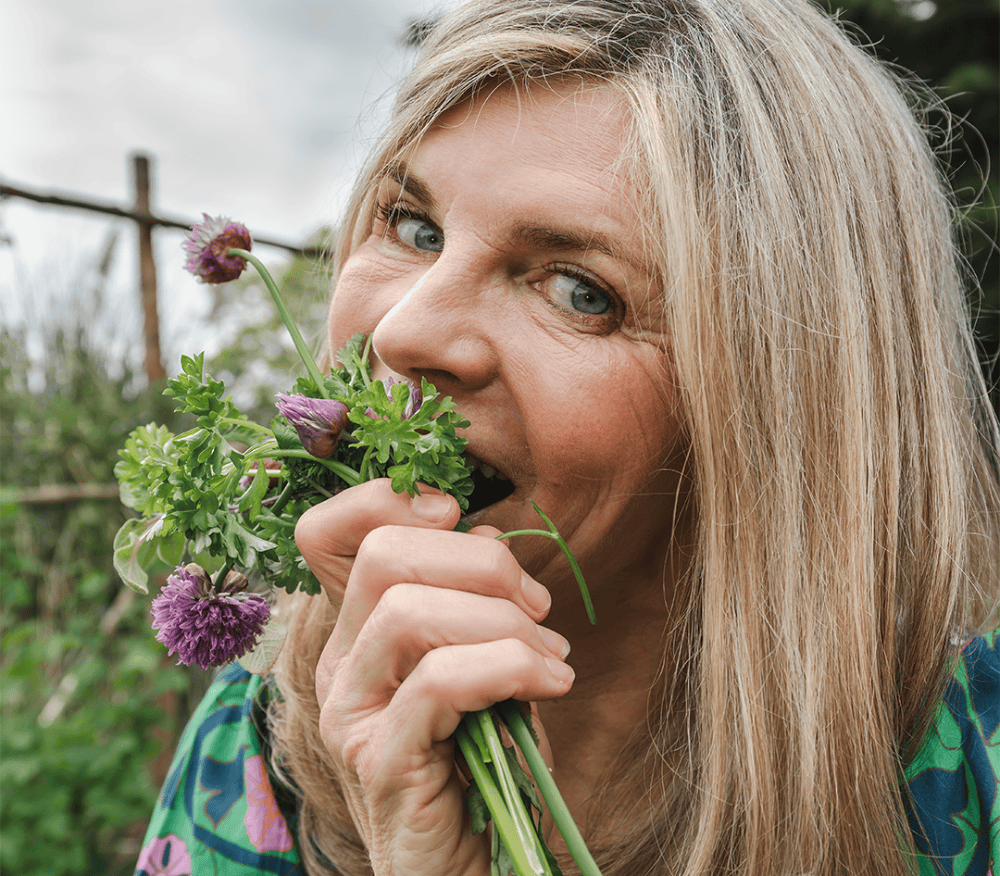We're exploring the link between your garden and your gut, asking our experts whether you can really eat your garden to help your gut health. Inspired and in support of the Bowel Research UK Microbiome Garden which showed at this year’s RHS Chelsea Flower Show.
Our top five things you can do in your garden for your gut
Because it’s not just about eating your garden but getting back outside in nature as well.
1. Include edible plants
Sid Hill recommends including edible plants in your garden in your pots or borders. “Eating fresh food harvested from your garden is one of the best things you can do for your overall wellbeing. These do not need to be your standard vegetables. There are tens of thousands of edible plants available to us today. You could include some fruit, perennial vegetables or herbs. In fact, it is likely some of the plants in your garden are edible.”
2. Plant a container
“Container gardening (growing plants in containers) is perfect for beginners who want low-maintenance greenery,” says Dietitian Laura Tilt. “It’s also ideal if you have limited outdoor space, such as a balcony or small patio. You can repurpose pretty much any container to grow a plant as long as you create drainage holes at the bottom. Look around your house or local market for wooden boxes, oil cans, old tin baths, enamel pots you could upcycle, then choose a suitable plant according to the size of your container.”
3. Get your hands dirty
If you can, get outside, interact with nature, and get your hands dirty. "When we're out in the landscape, on the plant leaves, in the air, in the soil, there's millions of microbes that are transferred into our microbiome when we spend time in these landscapes, meaning the landscape itself can act as a probiotic.” A great fact from Sid Hill.
4. Create a calming nature nook
Laura Tilt recommends “finding a sunny corner of your garden or cosy window area that looks outdoors and create yourself a peaceful nature spot. Tidy up the space, add a few plants in pots and a seat. If you’re creating your nook indoors, add a few cushions and some potted plants for your desk and windowsill. Studies show that bringing nature indoors through houseplants can have a positive effect on mood and mental wellbeing.”
5. Take your activity outdoors
Commit to taking a daily walk in a green space, or move your usual movement (be that running, cycling or yoga) outdoors when the weather allows. This evening stretch from Michelle Griffith Robinson is the perfect way to destress and unwind after a hard day.
What is the Bowel Research UK Microbiome Garden?
The Bowel Research UK Microbiome Garden draws inspiration from medical and botanical research, exploring the fascinating connection between a healthy landscape and soil, a healthy gut, and a healthy mind. It aims to inspire people to rewild their diets, gardens and their relationship with the land.
So, what’s the link? And what’s soil got to do with it?
Dietitian Laura Tilt explains that “the soil under your feet is teeming with trillions of microbes, forming what is known as the soil microbiome. Much like your gut microbiome is vital for your health, this underground ecosystem is vital for soil health and the food that grows in it."
“Protecting and improving the diversity of the soil microbiome is essential to sustaining food production and nutritious food. Healthy soils = more crops, and improved nutrition of those crops. In short, your health (and gut health) is connected to the health of the soil.”
But can you really eat your garden for your gut?
We asked the brilliant garden designers, Sid Hill and Chris Hull, which plants you may not realise are edible.
"We’re highlighting a trio of beautiful plants which are commonly grown in gardens, but which few people know are actually great food crops which could offer a myriad of gut health and microbiome benefits.”
These include:
Bistorta
Boasts pale pink bottle-brush flowers on leafless stalks, creating an airy meadow aesthetic as they gently float above the planting. While commonly grown for its ornamental value in gardens, it remains a hidden ingredient, with few recognising its extensive history as a green vegetable in the UK.
Camassia
Provides contrast with its vivid blue flower spikes and weaves into the edible narrative of the garden with its bulbs that have been used by indigenous north American people for generations.
Lupinus luteus
Has been chosen for its long history of use by people for food in the Mediterranean, its benefit to the human microbiome when its seeds are prepared and consumed and by its beautiful yellow flowers that attract pollinators.
So it seems you can really eat your garden to support your gut microbiome. And as for Susannah Constantine, who sat in a wheelbarrow and ate a bouquet for us, what does her garden mean to her?
“Our garden is a source of so much pleasure come the spring and summer. Rhubarb (which I loathe) rears its large, leafed head and various herbs get picked and consumed daily. Apples, pears, plums and figs get bottled, pickled and frozen for the winter months. Gooseberries are made into fool and blackberries from the hedgerows turn into crumble.”
Dig into more
Meet the Designers Behind the Bowel Research UK Microbiome Garden
We asked Sid and Chris to give us the lowdown on their pioneering edible meadow in the Bowel Research UK Microbiome Garden at RHS Chelsea Flower Show.
Can gardening benefit your gut health?
Ever looked closely at the soil? It’s teaming with microbes, just like your gut microbiome. Dietitian Laura Tilt explains the connection and why green fingers can mean a healthy gut.
Susannah Constantine’s 3 daily non-negotiables
Find out why routine is essential for Susannah Constantine and the three things she swears by to kickstart her mornings.
Why is 30 plant points the magic number? And how do you get there? Registered Nutritionist Rhiannon Lambert shares how it might be easier than you think to bump your weekly numbers.
Save 20% on your first 12 weeks
Ready to start your journey? A flexible subscription is the best way to get going and trial Symprove.










